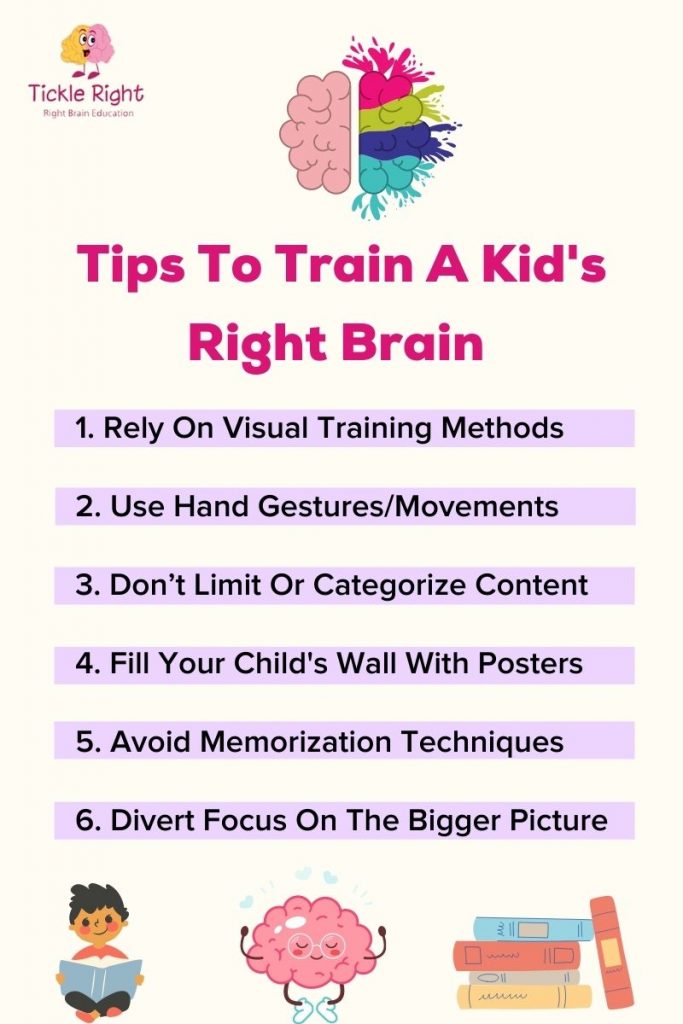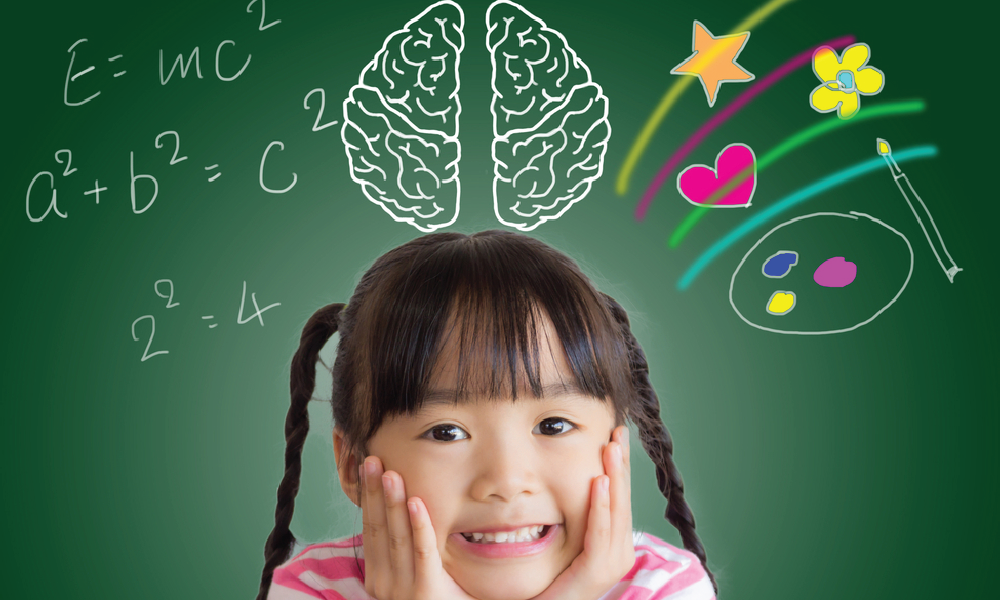Redefining Social Interaction in the Digital Era Today’s children are growing up in a world where digital screens often replace playgrounds and emojis replace expressions. While technology has its benefits, like access to learning tools, global exposure, and creative platforms, it has also quietly reduced the quality of real, face-to-face interactions. And here’s the truth: No app can replicate...
6 Tips To Train A Kid’s Right Brain
6 Tips To Train A Kid’s Right Brain
All children are born genius! Aren’t they? Since a child’s brain is the most progressive organ that we know of. Helping your little one make the best of their talent & unique skills is directly associated with it. You must engage your child in the right learning processes. These processes help you tap into your child’s potential & maximize their cerebral functions. The ability to plan, organize, and understand others’ perspectives helps them regulate their life well.
A child’s brain development also aims to create a balance between both brain hemispheres. Since the two brain parts are closely connected by a web of neural fibers. It helps communicate with each other & sends signals. We at Tickle Right work towards creating the most splendid synergy amongst the hemispheres. The main purpose is not to only utilize the child’s right or left brain hemisphere. Instead, it’s an opportunity for your child’s brain more friendly with the learning processes.
What Is Right Brain Education?
Right Brain Education is an advanced child development program catering to specific child growth activities. It aims at helping children develop significant life skills. Like, such greater confidence, creative intelligence, photographic memory, emotional enlightenment, & others. It is specially designed for children between 1.5 to 7 years. Since the main purpose is to strengthen the right side of a child’s brain. It helps provide the right exposure to instill a lifelong love for learning in a fun yet interesting manner.
A child’s brain intrinsically develops rapidly during the early years of their childhood. It provides the much-required exposure to help your child experience the wonders of right-brain training. It helps a child set the bedrock for better clarity of thoughts, academic excellence, & loving personality.
Is Your Child A Right-Brained Dominant Learner?
Do you often presume in doubt that your child is a right-brained learner? Because they would love to be shown than told to perform a task. It’s their unique way of understanding information & making it easy for themselves. The learning strengths of a child extend to processing new information via movements, visuals, and emotions. They primarily thrive on personal early childhood experiences & feelings to nurture their actions. It helps them stay connected with the environment. This reflects better efficiency as they learn about new things with the stimulation of their right-brained characteristics.
In a world full of left-brain dominant learners, you must help your child pursue their talents strategically. It is important to think beyond conventional educational practices. The strengths of right-brain learners help them relate to a problem duly. They come up with unique logical solutions by also taking into consideration others’ emotions. However, your little one must be introduced to these learning opportunities from an early age. This helps them harness their strengths & build some skills around them.
What Are Right-Brain Learner’s Characteristics?
Right-brain learners are influenced by the extraordinary means of helping them process information. This excellent way of learning has a lot to do with their right-brained characteristics. Therefore, given below are the primary attributes of a right-brain learner –
Kinesthetic Behavioral Learning
- Learning via physically understanding the subject matter
- Must be able to see, touch, or move the subject for better understanding
- Learns best about new things kinesthetically
Visual Behavioral Learning
- Learning via concentrating on the whole picture
- Must be able to see the picture to break information down
- Remembers best with the memory of images
Auditory Behavioral Learning
- Learning via listening carefully about the particular topic
- Must have the access to audiobooks, or even light music to process data
- Grasps better via listening, speaking, & interacting
Emotional Behavioral Learning
- Relates with others based on their childhood experiences
- Must need some alone time to pick up the intention/emotion
- Performs best via being highly intuitive & connecting with emotions
6 Tips To Strengthen Your Child’s Right Side Brain Development
Your child’s right brain development is an attempt to channel their attention into academic & non-academic brilliance. A left-brain dominant child would easily concentrate on getting their work done. They’re apt at planning & structuring their work. However, a right-brain dominant child utilizes their creative intelligence to get to the point. They love patterns, connections, pictures, & most of all games! They have a good memory to absorb information for longer durations.
So, if you already recognize a few of these right-brained traits, contact us! Your child’s learning potential requires early & fun techniques to process information. Besides, here are a few tips to strengthen your child’s right side brain development:

Rely On Visual Training Methods
Visual training benefits extend to helping your child connect the dots. It helps sky-rocket their learning potential by simply relying on images. Since right-brain learners respond well to sketches, images, or flashcards. This helps develop a photographic memory for long-term data retention. You must introduce your child to a mind mapping approach. This helps process information in a visually empowered manner. This naturally boosts their learning potential. Tools such as presentations, patterns, rhymes, and graphic organizers shall work best for children.
Use Hand Gestures/Body Movements
Teaching directly from the textbooks isn’t enough for your little one. And as they assert, actions speak louder than words. Let’s chase it to help your little one! Using hand gestures or body movements helps a child directly relate to the subject information. They help them grasp better and improve their chances of successfully processing the information. It also encourages language & social development to promote overall communication development. While helping your child learn alphabets or rhymes, you must involve hand gestures. It helps them remember the sequence or associate with them.
Don’t Limit Or Categorize Content
The natural tendency to organize different bits of information is another common method of teaching kids. This is done to help a child extract information in a better manner. Although, this might not be the case with the right-brain learners. Presenting the whole information in front of them gives a finer sense of understanding. If the data is handed in bits in a controlled manner, this may lead to a lack of attention or a state of confusion. Right brain learners perform well with the assistance of complete information. This way, they are able to visualize things from a long-term memory development perspective.
Fill The Wall With Posters
What better way to help your child with their learning potential than this. You must fill your child’s room walls with giant chart papers. These posters can include information related to alphabets, numbers, animals, shapes, body parts, words, & others. You must not forget to put a lot of emphasis on the visuals of the posters. As right-brain learners love images, this will interest them to be engaged in learning. This will also help them boost their vocabulary & lay the foundation for cognitive development skills.
Avoid Memorization Techniques
Another correct way to maximize your child’s hidden potential is by helping them understand the concepts. Because even if your child has mugged-up topics, it will only stay in for a matter of time. Laying emphasis on unhealthy memorization techniques will not help your little one fetch long-term fruitful results. Instead, it reduces a child’s attention span to a much shorter duration. You must help your child learn to process information via different methods of learning. Like pattern-seeking, visuals, rhymes, & others.
Focus On The Bigger Picture
Right brain learners need to understand the entire perspective of a concept/situation to move ahead. This helps them understand different applications of a single concept. Since right-brain dominant children are highly intuitive in their subconscious minds. Understanding the whole picture of a concept, getting familiar with it, spend time visualizing it works better for them. This helps them break down the information into parts. Whether it is any basic or heaviest of the information for them to process, this technique of lists & visuals will never disappoint you.
FAQs
What activities are right brain?
The following are the right brain activities for a child to activate their right brain –
- Art/Painting
- Playing Music
- Flashcards Play
- Imaging
- Storytelling
How can you stimulate your child’s right brain?
Right brain activities help stimulate both the hemispheres of a child’s brain. Not just the right side itself. Since the two hemispheres are connected by a network of neural fibers. It helps establish the most excellent synergy. A synergy that caters to both hemisphere’s characteristics. A child’s early childhood experiences have a great impact on their future habits. It sets the foundations for cognitive development skills & some major life skills. Like, such social skills, empathy, photographic memory, critical skills, & others
How do you train both sides of your child’s brain?
The following are the activities that help activate both the sides of your child’s brain –
- Solving puzzles
- Reading/writing
- Dramatic role playing
- Word/block games
- Introducing flashcards
- Art/painting
Takeaway

Visuals, patterns, music, & games are a great way to grab the attention of your little one. This helps them process information & assists in developing a whole-to-part approach. This is a direct way to enable your child to brush up on their learning skills. Since right-brain learners need to build connections & logic to process information. This will have a positive impact on their long-term memory for the data & in general.

